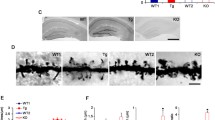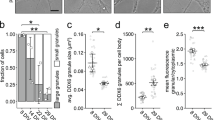Abstract
microRNAs play an important role in regulating synaptic plasticity. For example, microRNAs target (and are targeted by) plasticity mediators such as CREB, MECP2, and FMRP. As well, specific microRNAs have been shown to be expressed within dendrites, where they regulate protein translation of targets mediating dendritic growth. Components of the RISC machinery have been implicated in long-term memory in Drosophila. Here, we review evidence from studies of adult mouse forebrain supporting a model wherein synaptic stimulation (above a threshold value) increases calcium within dendritic spines, activates calpain, and activates and releases dicer from the postsynaptic density. Dicer processes local pre-miRs into mature miRNAs that are incorporated into RISC complexes within or near the dendritic spine, and that bind available target mRNAs in the vicinity. These may repress protein translation under resting conditions, yet permit a phasic burst of translation to occur transiently following subsequent synaptic activity. Loaded RISC complexes that are not bound to local mRNAs may serve to bind and trap mRNAs that are being transported down dendrites. Thus, locally formed microRNAs may mark the location of previously activated synapses and perform a type of synaptic tagging and capture.




Similar content being viewed by others
References
Abu-Elneel, K., Liu, T., Gazzaniga, F. S., Nishimura, Y., Wall, D. P., Geschwind, D. H., et al. (2008). Heterogeneous dysregulation of microRNAs across the autism spectrum. Neurogenetics, 9, 153–161. doi:10.1007/s10048-008-0133-5.
Asaki, C., Usuda, N., Nakazawa, A., Kametani, K., & Suzuki, T. (2003). Localization of translational components at the ultramicroscopic level at postsynaptic sites of the rat brain. Brain Research, 972, 168–176. doi:10.1016/S0006-8993(03)02523-X.
Ashraf, S. I., McLoon, A. L., Sclarsic, S. M., & Kunes, S. (2006). Synaptic protein synthesis associated with memory is regulated by the RISC pathway in Drosophila. Cell, 124, 191–205. doi:10.1016/j.cell.2005.12.017.
Barco, A., Lopez de Armentia, M., & Alarcon, J. M. (2008). Synapse-specific stabilization of plasticity processes: The synaptic tagging and capture hypothesis revisited 10 years later. Neuroscience and Biobehavioral Reviews, 32, 831–851. doi:10.1016/j.neubiorev.2008.01.002.
Beveridge, N. J., Tooney, P. A., Carroll, A. P., Gardiner, E., Bowden, N., Scott, R. J., et al. (2008). Dysregulation of miRNA 181b in the temporal cortex in schizophrenia. Human Molecular Genetics, 17, 1156–1168. doi:10.1093/hmg/ddn005.
Bourne, J. N., Sorra, K. E., Hurlburt, J., & Harris, K. M. (2007). Polyribosomes are increased in spines of CA1 dendrites 2 h after the induction of LTP in mature rat hippocampal slices. Hippocampus, 2007(17), 1–4. doi:10.1002/hipo.20238.
Dincbas-Renqvist, V., Pépin, G., Rakonjac, M., Plante, I., Ouellet, D. L., Hermansson, A., et al. (2009). Human Dicer C-terminus functions as a 5-lipoxygenase binding domain. Biochimica et Biophysica Acta, 1789, 99–108.
Duman, R. S. (2002). Pathophysiology of depression: the concept of synaptic plasticity. European Psychiatry, 17(Suppl 3), 306–310. doi:10.1016/S0924-9338(02)00654-5.
Eis, P. S., Tam, W., Sun, L., Chadburn, A., Li, Z., Gomez, M. F., et al. (2005). Accumulation of miR-155 and BIC RNA in human B cell lymphomas. Proceedings of the National Academy of Sciences of the United States of America, 102, 3627–3632. doi:10.1073/pnas.0500613102.
Glanzer, J., Miyashiro, K. Y., Sul, J. Y., Barrett, L., Belt, B., Haydon, P., et al. (2005). RNA splicing capability of live neuronal dendrites. Proceedings of the National Academy of Sciences of the United States of America, 102, 16859–16864. doi:10.1073/pnas.0503783102.
Hansen, T., Olsen, L., Lindow, M., Jakobsen, K. D., Ullum, H., Jonsson, E., et al. (2007). Brain expressed microRNAs implicated in schizophrenia etiology. PLoS ONE, 2, e873. doi:10.1371/journal.pone.0000873.
John, B., Enright, A. J., Aravin, A., Tuschl, T., Sander, C., & Marks, D. S. (2004). Human MicroRNA targets. PLoS Biology, 2, e363. doi:10.1371/journal.pbio.0020363.
Khan, A. A., Betel, D., Sander, C., Leslie, C. S., & Marks, D. S. (2009). Nature Biotechnology, (in press).
Kim, V. N., Han, J., & Siomi, M. C. (2009). Biogenesis of small RNAs in animals. Nature Reviews. Molecular Cell Biology, 10, 126–139. doi:10.1038/nrm2632.
Kim, S. H., Markham, J. A., Weiler, I. J., & Greenough, W. T. (2008). Aberrant early-phase ERK inactivation impedes neuronal function in fragile X syndrome. Proceedings of the National Academy of Sciences of the United States of America, 105, 4429–4434. doi:10.1073/pnas.0800257105.
Kiyosawa, H., Mise, N., Iwase, S., Hayashizaki, Y., & Abe, K. (2005). Disclosing hidden transcripts: mouse natural sense–antisense transcripts tend to be poly(A) negative and nuclear localized. Genome Research, 15, 463–474. doi:10.1101/gr.3155905.
Klein, M. E., Lioy, D. T., Ma, L., Impey, S., Mandel, G., & Goodman, R. H. (2007). Homeostatic regulation of MeCP2 expression by a CREB-induced microRNA. Nature Neuroscience, 10, 1513–1514. doi:10.1038/nn2010.
Kosik, K. S. (2006). The neuronal microRNA system. Nature Reviews. Neuroscience, 7, 911–920. doi:10.1038/nrn2037.
Kye, M. J., Liu, T., Levy, S. F., Xu, N. L., Groves, B. B., Bonneau, R., et al. (2007). Somatodendritic microRNAs identified by laser capture and multiplex RT-PCR. RNA, 13, 1224–1234. doi:10.1261/rna.480407.
Li, Y., Lin, L., & Jin, P. (2008). The microRNA pathway and fragile X mental retardation protein. Biochimica et Biophysica Acta, 1779, 702–705.
Lugli, G., Larson, J., Martone, M. E., Jones, Y., & Smalheiser, N. R. (2005). Dicer and eIF2c are enriched at postsynaptic densities in adult mouse brain and are modified by neuronal activity in a calpain-dependent manner. Journal of Neurochemistry, 94, 896–905. doi:10.1111/j.1471-4159.2005.03224.x.
Lugli, G., Torvik, V. I., Larson, J., & Smalheiser, N. R. (2008). Expression of microRNAs and their precursors in synaptic fractions of adult mouse forebrain. Journal of Neurochemistry, 106, 650–661. doi:10.1111/j.1471-4159.2008.05413.x.
Martin, K. C., & Kosik, K. S. (2002). Synaptic tagging—Who’s it? Nature Reviews. Neuroscience, 3, 813–820. doi:10.1038/nrn942.
Narayanan, U., Nalavadi, V., Nakamoto, M., Pallas, D. C., Ceman, S., Bassell, G. J., et al. (2007). FMRP phosphorylation reveals an immediate-early signaling pathway triggered by group I mGluR and mediated by PP2A. Journal of Neuroscience, 27, 14349–14357. doi:10.1523/JNEUROSCI.2969-07.2007.
Nomura, T., Kimura, M., Horii, T., Morita, S., Soejima, H., Kudo, S., et al. (2008). MeCP2-dependent repression of an imprinted miR-184 released by depolarization. Human Molecular Genetics, 17, 1192–1199. doi:10.1093/hmg/ddn011.
Omi, K., Tokunaga, K., & Hohjoh, H. (2004). Long-lasting RNAi activity in mammalian neurons. FEBS Letters, 558, 89–95. doi:10.1016/S0014-5793(04)00017-1.
Park, S., Park, J. M., Kim, S., Kim, J. A., Shepherd, J. D., Smith-Hicks, C. L., et al. (2008). Elongation factor 2 and fragile X mental retardation protein control the dynamic translation of Arc/Arg3.1 essential for mGluR-LTD. Neuron, 59, 70–83. doi:10.1016/j.neuron.2008.05.023.
Park, C. S., & Tang, S. J. (2008). Regulation of microRNA Expression by Induction of Bidirectional Synaptic Plasticity. Journal of Molecular Neuroscience, 38, 50–66. doi:10.1007/s12031-008-9158-3.
Perkins, D. O., Jeffries, C. D., Jarskog, L. F., Thomson, J. M., Woods, K., Newman, M. A., et al. (2007). microRNA expression in the prefrontal cortex of individuals with schizophrenia and schizoaffective disorder. Genome Biology, 8, R27. doi:10.1186/gb-2007-8-2-r27.
Provost, P., Dishart, D., Doucet, J., Frendewey, D., Samuelsson, B., & Radmark, O. (2002). Ribonuclease activity and RNA binding of recombinant human Dicer. EMBO Journal, 21, 5864–5874. doi:10.1093/emboj/cdf578.
Ramachandran, V., & Chen, X. (2008). Degradation of microRNAs by a family of exoribonucleases in Arabidopsis. Science, 321, 1490–1492. doi:10.1126/science.1163728.
Schratt, G. M., Tuebing, F., Nigh, E. A., Kane, C. G., Sabatini, M. E., Kiebler, M., et al. (2006). A brain-specific microRNA regulates dendritic spine development. Nature, 439, 283–289. doi:10.1038/nature04367.
Smalheiser, N. R. (2008a). Regulation of mammalian microRNA processing and function by cellular signaling and subcellular localization. Biochimica et Biophysica Acta, 1779, 678–681.
Smalheiser, N. R. (2008b). Synaptic enrichment of microRNAs in adult mouse forebrain is related to structural features of their precursors. Biology Direct, 3, 44. doi:10.1186/1745-6150-3-44.
Smalheiser, N. R., Lugli, G., Lenon, A. L., & Larson, J. (manuscript submitted).
Smalheiser, N. R., Lugli, G., Rizavi, H. S., Turecki, D., Torvik, V. I., & Dwivedi, Y. (2009). (manuscript submitted).
Smalheiser, N. R., Lugli, G., Torvik, V. I., Mise, N., Ikeda, R., & Abe, K. (2008). Natural antisense transcripts are co-expressed with sense mRNAs in synaptoneurosomes of adult mouse forebrain. Neuroscience Research, 62, 236–239. doi:10.1016/j.neures.2008.08.010.
Smalheiser, N. R., Manev, H., & Costa, E. (2001). RNAi and brain function: Was McConnell on the right track? Trends in Neurosciences, 24, 216–218. doi:10.1016/S0166-2236(00)01739-2.
Suzuki, T., Tian, Q. B., Kuromitsu, J., Kawai, T., & Endo, S. (2007). Characterization of mRNA species that are associated with postsynaptic density fraction by gene chip microarray analysis. Neuroscience Research, 57, 61–85. doi:10.1016/j.neures.2006.09.009.
Vasudevan, S., Tong, Y., & Steitz, J. A. (2007). Switching from repression to activation: microRNAs can up-regulate translation. Science, 318, 1931–1934. doi:10.1126/science.1149460.
Velleca, M. A., Wallace, M. C., & Merlie, J. P. (1994). A novel synapse-associated noncoding RNA. Molecular and Cellular Biology, 14, 7095–7104.
Vo, N., Klein, M. E., Varlamova, O., Keller, D. M., Yamamoto, T., Goodman, R. H., et al. (2005). cAMP-response element binding protein-induced microRNA regulates neuronal morphogenesis. Proceedings of the National Academy of Sciences of the United States of America, 102, 16426–16431. doi:10.1073/pnas.0508448102.
Wayman, G. A., Davare, M., Ando, H., Fortin, D., Varlamova, O., Cheng, H. Y., et al. (2008). An activity-regulated microRNA controls dendritic plasticity by down-regulating p250GAP. Proceedings of the National Academy of Sciences of the United States of America, 105, 9093–9098. doi:10.1073/pnas.0803072105.
Weiler, I. J., Spangler, C. C., Klintsova, A. Y., Grossman, A. W., Kim, S. H., Bertaina-Anglade, V., et al. (2004). Fragile X mental retardation protein is necessary for neurotransmitter-activated protein translation at synapses. Proceedings of the National Academy of Sciences of the United States of America, 101, 17504–17509. doi:10.1073/pnas.0407533101.
Weinmann, L., Höck, J., Ivacevic, T., Ohrt, T., Mütze, J., Schwille, P., et al. (2009). Importin 8 is a gene silencing factor that targets argonaute proteins to distinct mRNAs. Cell, 136, 496–507. doi:10.1016/j.cell.2008.12.023.
Wu, J., & Xie, X. (2006). Comparative sequence analysis reveals an intricate network among REST, CREB and miRNA in mediating neuronal gene expression. Genome Biology, 7, R85. doi:10.1186/gb-2006-7-9-r85.
Xu, X. L., Li, Y., Wang, F., & Gao, F. B. (2008). The steady-state level of the nervous-system-specific microRNA-124a is regulated by dFMR1 in Drosophila. Journal of Neuroscience, 28, 11883–11889. doi:10.1523/JNEUROSCI.4114-08.2008.
Zeng, Y., Sankala, H., Zhang, X., & Graves, P. R. (2008). Phosphorylation of Argonaute 2 at serine-387 facilitates its localization to processing bodies. Biochemical Journal, 413, 429–436. doi:10.1042/BJ20080599.
Zhang, H., Kolb, F. A., Brondani, V., Billy, E., & Filipowicz, W. (2002). Human Dicer preferentially cleaves dsRNAs at their termini without a requirement for ATP. EMBO Journal, 21, 5875–5885. doi:10.1093/emboj/cdf582.
Zhou, R., Yuan, P., Wang, Y., Hunsberger, J. G., Elkahloun, A., Wei, Y., et al. (2009). Evidence for selective microRNAs and their effectors as common long-term targets for the actions of mood stabilizers. Neuropsychopharmacology, 34, 1395–1405. doi:10.1038/npp.2008.131.
Acknowledgments
We are grateful to Drs. John Larson, Yogesh Dwivedi, and Vetle Torvik for their expert collaborations. Our research was supported by NIH grants DA15450, MH81099, DC 05793, and LM07292 and by the Stanley Medical Research Institute. The contents of this article are solely the responsibility of the authors and do not necessarily represent the official views of NIH.
Author information
Authors and Affiliations
Corresponding author
Rights and permissions
About this article
Cite this article
Smalheiser, N.R., Lugli, G. microRNA Regulation of Synaptic Plasticity. Neuromol Med 11, 133–140 (2009). https://doi.org/10.1007/s12017-009-8065-2
Received:
Accepted:
Published:
Issue Date:
DOI: https://doi.org/10.1007/s12017-009-8065-2




